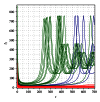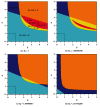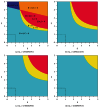Modeling the spread of tuberculosis in semiclosed communities
- PMID: 23762194
- PMCID: PMC3665242
- DOI: 10.1155/2013/648291
Modeling the spread of tuberculosis in semiclosed communities
Abstract
We address the problem of long-term dynamics of tuberculosis (TB) and latent tuberculosis (LTB) in semiclosed communities. These communities are congregate settings with the potential for sustained daily contact for weeks, months, and even years between their members. Basic examples of these communities are prisons, but certain urban/rural communities, some schools, among others could possibly fit well into this definition. These communities present a sort of ideal conditions for TB spread. In order to describe key relevant dynamics of the disease in these communities, we consider a five compartments SEIR model with five possible routes toward TB infection: primary infection after a contact with infected and infectious individuals (fast TB), endogenous reactivation after a period of latency (slow TB), relapse by natural causes after a cure, exogenous reinfection of latently infected, and exogenous reinfection of recovered individuals. We discuss the possible existence of multiple endemic equilibrium states and the role that the two types of exogenous reinfections in the long-term dynamics of the disease could play.
Figures
















References
-
- Castillo-Chavez C, Song B. Dynamical models of tuberculosis and applications. Mathematical Biosciences and Engineering. 2004;1:361–404. - PubMed
-
- Raffalli J, Sepkowitz KA, Armstrong D. Community-based outbreaks of tuberculosis. Archives of Internal Medicine. 1996;156(10):1053–1060. - PubMed
-
- Chiang CY, Riley LW. Exogenous reinfection in tuberculosis. The Lancet Infectious Diseases. 2005;5(10):629–636. - PubMed
Publication types
MeSH terms
LinkOut - more resources
Full Text Sources
Other Literature Sources

